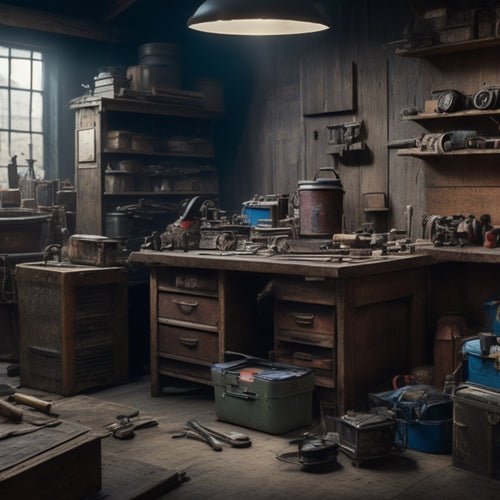
Why Your Workshop Workflow Is Holding You Back
Share
You're wasting time and money in your workshop due to hidden inefficiencies. Your tool organization system is likely a mess, making it hard to find what you need when you need it. Material preparation is another bottleneck, causing delays and affecting project quality. Your workspace design might also be flawed, leading to wasted time and energy. Additionally, poor project planning strategies and a lack of visual inventory control are probably hindering your productivity. Identify and address these issues to optimize your workflow, and discover the specific tweaks you can make to open up your workshop's full potential.
Key Takeaways
• Poor tool organization and inefficient workshop layout lead to wasted time and reduced productivity.
• Inadequate material preparation and maintenance cause project delays and affect quality.
• Inefficient workspace design and poor ergonomics result in fatigue, errors, and decreased productivity.
• Lack of clear project goals, timelines, and resource allocation lead to procrastination and inefficiency.
• Ineffective inventory management and tracking lead to material shortages, delays, and wasted resources.
Inefficient Tool Organization Systems
Failing to implement a well-organized tool organization system hinders your ability to quickly locate and access the tools you need, ultimately wasting valuable time and decreasing productivity. When you're constantly searching for misplaced tools, you're taking away from the time you could be spending on actual projects.
Effective tool storage is vital in maintaining a smooth workflow. You should designate specific areas for specific tools, making it easy to find what you need when you need it. A well-arranged workshop layout can also help you move around efficiently, reducing the time spent walking back and forth to fetch tools.
Consider categorizing your tools by type, frequency of use, or project-specific needs. This will enable you to quickly identify where each tool is stored. Labeling your storage containers and areas can also help you and others quickly locate tools.
Bottlenecks in Material Preparation
As you've optimized your tool organization system, you're now ready to tackle the next hurdle: preparing materials efficiently, which can be a significant bottleneck in your workflow if not done correctly.
Inefficient material preparation can lead to wasted time and energy, ultimately affecting the quality of your projects.
An important aspect of material preparation is proper material storage. Make sure that your storage system is well-organized, easily accessible, and protected from environmental factors that can damage your materials. This will save you time searching for materials and reduce the risk of damage or loss.
Regular tool maintenance is also essential in material preparation. Dull or poorly maintained tools can lead to inaccurate cuts, waste, and even safety hazards. Schedule regular tool maintenance to guarantee your tools are in top condition, and you'll be able to work efficiently and accurately.
Wasted Time Searching for Tools
Your inefficient tool organization system is costing you valuable time, leaving you to sift through a cluttered workshop in search of the right tool for the job. You're not alone - many workshop owners struggle with tool disorganization, leading to wasted hours and decreased productivity.
It's crucial to establish a tool maintenance routine to make sure your tools are in good working condition and easily accessible. This includes regular cleaning, lubricating, and storing tools in designated areas.
Effective inventory tracking is also vital to avoiding tool-related downtime. By maintaining an accurate record of your tools and their locations, you can quickly identify what's missing and what needs to be replenished. Consider using a tool tracking system, such as a spreadsheet or mobile app, to streamline your inventory management.
With a well-organized tool system, you'll spend less time searching for tools and more time focusing on the task at hand. By optimizing your tool organization and maintenance, you'll be able to work more efficiently, increase productivity, and get more done in less time.
Inadequate Workspace Design Flaws
A poorly designed workspace is hindering your workflow, forcing you to navigate around obstacles and awkwardly positioned equipment, which leads to wasted time and energy. You're constantly adjusting your body to fit into tight spaces, straining your back and neck, and expending effort to reach tools and materials that are out of reach.
It's time to rethink your workspace design. Ergonomic workstations and an optimized layout can make a significant difference. By positioning equipment and tools in a way that minimizes strain and maximizes efficiency, you'll be able to work smarter, not harder.
Effective lighting is also vital, as it can reduce eye strain and improve visibility. Don't forget about proper ventilation, which is essential for removing dust, fumes, and other airborne contaminants that can negatively impact your health and productivity.
Poor Project Planning Strategies
When you're stuck in a workshop workflow that's not working, it's often because you're not setting yourself up for success from the start.
You're likely guilty of poor project planning strategies that hinder your progress and cause frustration.
Take a closer look at your approach: are you setting clear goals, creating realistic timelines, and allocating resources effectively?
Lack of Clear Goals
Deadlines loom, but without explicit goals, you're stuck in neutral, wasting valuable time and resources on a project that's going nowhere. You're not alone; many workshops struggle with goal setting, which hinders productivity and slows progress. Without a definite direction, you're left wondering what needs to be done, and your team is left lacking motivation.
To get back on track, you need to establish precise objectives for your project. What do you want to achieve? What does success look like? By setting specific, measurable, and achievable goals, you'll be able to focus your efforts and allocate resources effectively. Establishing success metrics will also help you track progress and make adjustments as needed.
Clear goals will help you prioritize tasks, allocate resources, and make informed decisions. They'll give you a sense of direction and purpose, helping you stay focused and motivated.
Unrealistic Timelines Set
You're stuck with a project schedule that's overly ambitious, setting your team up for failure from the get-go. Unrealistic timelines lead to rushed work, mistakes, and burnout. It's time to reassess your project planning strategies and focus on realistic time management.
Start by identifying the most critical tasks that drive the project's success. Prioritize these tasks using the Eisenhower Matrix, categorizing them into urgent vs. important, and focus on the most critical ones first.
Next, optimize your workflow by breaking down large tasks into smaller, manageable chunks. This will help you allocate sufficient time for each task and avoid last-minute rushes. Remember, productivity isn't about working longer hours, but about working smarter.
Take regular breaks, and make certain your team is well-rested and motivated. By setting realistic timelines and prioritizing tasks effectively, you'll be able to deliver high-quality results without sacrificing your team's well-being.
Inadequate Resource Allocation
By prioritizing tasks effectively, you've taken the first step towards realistic project planning, but now it's time to make sure you have the necessary resources to execute them efficiently. Inadequate resource allocation can quickly derail even the best-laid plans, leading to delays, inefficiencies, and decreased productivity.
To avoid this, you need to focus on resource management and time allocation. This means identifying the resources required for each task, including personnel, equipment, and materials, and ensuring they're available when needed.
Effective resource allocation is critical for productivity optimization. By allocating resources efficiently, you can minimize waste, reduce downtime, and maximize output. This, in turn, enables you to complete tasks quickly and move on to the next priority.
Lack of Visual Inventory Control
Without a visual inventory management system, parts and materials are likely scattered throughout your workshop, making it challenging for you to quickly identify what's in stock and what needs to be reordered. This lack of visual organization leads to wasted time searching for specific components, and it's easy to overlook items that are running low.
As a result, you might end up over-ordering or under-ordering essential materials, which can disrupt your workflow and impact your bottom line.
Implementing a visual inventory management system can revolutionize your inventory tracking. By labeling and categorizing your stock, you can easily see what you have on hand and what's running low. This allows you to make informed decisions about reordering and guarantees that you always have the materials you need to complete projects efficiently.
With a visual system in place, you'll reduce waste, save time, and increase productivity. By taking control of your inventory, you'll be able to focus on what matters most – delivering high-quality work and growing your business.
Frequently Asked Questions
How Do I Prioritize Tasks When Multiple Projects Have Urgent Deadlines?
When multiple projects have urgent deadlines, you prioritize tasks by allocating time based on project importance and deadline proximity. Focus on high-priority tasks, break them down into manageable chunks, and tackle them one by one.
Can a Workshop Workflow Be Optimized for a Team of One Person?
"Streamline your solo workflow by syncing schedules, slashing distractions, and sharpening time management skills, allowing you to tackle your solo project with precision, prioritize tasks efficiently, and maximize productivity."
What Technology Can Help Streamline Workshop Operations and Reduce Waste?
You can leverage technology to streamline workshop operations and reduce waste by implementing inventory management systems and automation solutions, such as workflow software and robotic process automation, to maximize efficiency and minimize errors.
How Often Should I Reassess and Adjust My Workshop Workflow Process?
Imagine watching your workshop hum like a well-oiled machine. You should reassess and adjust your workflow process regularly, ideally every 3-6 months, to guarantee efficient time management, effective task delegation, and seamless communication.
Are There Any Workflow Optimization Strategies Specific to My Industry?
You'll find industry benchmarks and best practices to optimize your workflow, but don't stop there - explore customized solutions that leverage automation benefits, tailoring them to your unique needs and pain points for maximum efficiency.
Related Posts
-

7 Essential Foldable Workbenches for Garages
When selecting a foldable workbench for your garage, you'll want to contemplate factors such as space-saving design, ...
-

10 Best Tool Boxes for Every Budget and Job
You're looking for a tool box that fits your budget and job requirements. Whether you're a DIY enthusiast, electricia...
-

Must-Try Bike Storage Ideas in Small Spaces
You're tired of sacrificing precious living space to store your bike, especially in small homes where every square fo...


